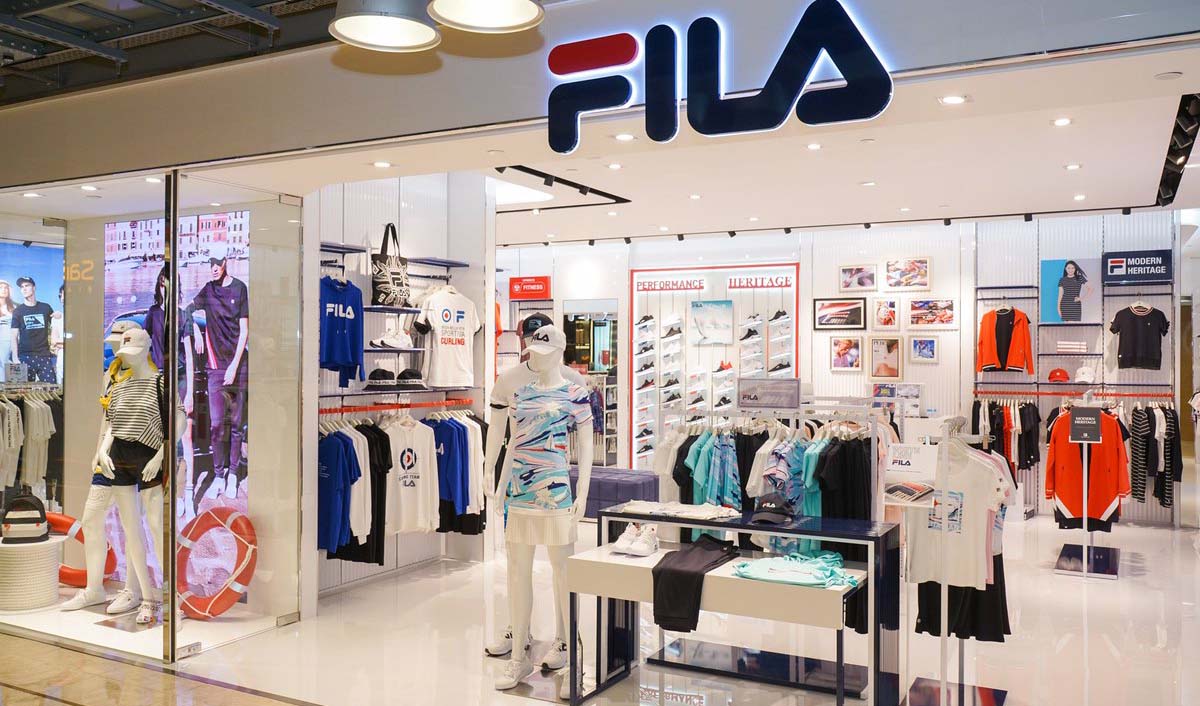In the world of athletic footwear and sportswear, few brands can rival the enduring legacy and iconic status of Fila. Established in 1911 in Biella, Italy, Fila has transformed itself from a small, regional textile manufacturer into a global powerhouse in the sports and lifestyle industry. With its distinctive logo and innovative designs, Fila has become synonymous with timeless style, performance, and an unmistakable sense of Italian craftsmanship. This article delves into the rich history, brand philosophy, product range, and cultural impact that have made Fila an enduring and beloved name in the realm of sports and fashion. In this article, we’ll delve into the Marketing Strategies and Marketing Mix of Fila.
Fila’s journey began over a century ago, founded by the Fila brothers, Giansevero and Ettore Fila. Initially specializing in producing high-quality textiles for the local community, the brand soon expanded its offerings to include luxury knitwear. However, it was not until the 1970s that Fila truly cemented its position in the sports industry. The brand’s innovative designs and commitment to performance excellence quickly gained recognition among professional athletes and sports enthusiasts worldwide.

Fila’s unique blend of sportswear and fashion is deeply rooted in Italian elegance and craftsmanship. The brand’s design ethos seamlessly combines functionality with style, creating products that not only enhance athletic performance but also make a fashion statement. Fila’s ability to merge athletic innovation with high-end fashion trends has made it a favorite among athletes, celebrities, and fashion-forward individuals alike.
Fila’s product portfolio spans a wide range of categories, including footwear, apparel, accessories, and even limited-edition collaborations. Fila’s footwear line encompasses everything from performance-driven athletic shoes to lifestyle sneakers that effortlessly transition from the gym to the streets. Each Fila shoe is meticulously crafted using cutting-edge technologies, premium materials, and attention to detail, ensuring optimal comfort and durability.
In addition to footwear, Fila offers an extensive collection of apparel that combines functionality, style, and a nod to its sporting heritage. From performance-oriented activewear to fashion-forward athleisure pieces, Fila’s clothing line caters to individuals seeking both performance and style in their wardrobe choices. The brand’s signature color palette, bold logos, and distinctive designs have become hallmarks of Fila’s aesthetic.
Fila’s influence extends beyond the realm of sports and fashion. The brand’s iconic status has led to numerous collaborations with renowned designers, athletes, and cultural icons. These collaborations have resulted in limited-edition releases that fuse Fila’s timeless designs with the unique visions of collaborators, further solidifying the brand’s relevance and cultural impact.
From its presence on the tennis courts with legendary athletes like Björn Borg to its prominent role in hip-hop culture during the ’90s, Fila has consistently remained at the forefront of style and pop culture. The brand’s ability to adapt and evolve while staying true to its heritage has ensured its enduring popularity across generations.
Marketing Strategies of Fila
Fila has implemented several marketing strategies over the years to establish its brand presence, engage with consumers, and drive sales. Here are some key marketing strategies employed by Fila:
Sponsoring athletes: One of the earliest and most successful marketing moves that Fila employed was sponsoring high profile athletes like Grand Slam champions Jimmy Connors and Kim Clijsters. By aligning themselves with top performers in various sports, Fila was able to gain visibility and credibility within the industry. This tactic helped position Fila as a serious player in the world of sport fashion apparel and accessories.
Collaborations: Another strategy that Fila has leveraged successfully is collaborations with other brands such as Le Coq Sportif, Fred Perry, and ASICS. These partnerships allowed Fila to tap into new markets and introduce unique co-branded products. For example, the collaboration with American Eagle Outfitters resulted in limited edition footwear and apparel designs targeted towards young adult consumers.
Celebrity Endorsements: To appeal to wider audiences, Fila has also signed celebrity endorsement deals with popular stars like Jennifer Garner, Christy Turlington, Halle Berry and Kendall Jenner. Having famous faces promote the brand helps create buzz and drive consumer interest.
Social media influencers campaigns: Recently, Fila has started partnering with social media influencers across different platforms to showcase their clothing lines. This approach allows the brand to reach larger demographic groups and connect with Millennial and Gen Z shoppers via digital channels that resonate strongly with these age cohorts.
Limited Edition Collections: To generate excitement and boost sales, Fila often releases limited edition collections featuring iconic styles from their archives. These special release collaborations encourage nostalgia among older fans while attracting new ones looking for exclusive pieces that are difficult to find elsewhere.
Retail Partnerships and Store Experiences: The Retail Store Experience (RSE) at Fila typically revolves around providing customers with an immersive and engaging atmosphere that highlights both the company’s heritage and modern lifestyle offerings. In addition to selling clothing and footwear, many Fila stores feature interactive elements designed to entertain and educate customers about the brand’s history and values.
Here are some common components of the RSE at Fila stores:
- Heritage Section: Many Fila stores have dedicated sections where customers can explore the brand’s rich history through displays, videos, and interactive exhibits. Visitors can learn about key milestones, influential figures, and notable achievements, which helps deepen emotional connections between them and the Fila brand.
- Interactive Digital Displays: Digital touchscreens allow customers to browse current collections, view product details, compare options side by side, and see styling suggestions, all while getting inspired by visually appealing content.
- Customization Stations: Some Fila stores offer customization services, allowing clients to add personal touches to their apparel or footwear choices. This experience not only enhances brand engagement but also generates higher sales conversions due to increased perceived value.
- Virtual Fitting Rooms: Augmented reality mirrors installed in fitting rooms permit users to virtually try on products without actually putting anything on. This technology reduces dressing room time and lets people preview combinations prior to making decisions. Plus, it keeps younger generations engaged and entertained during traditional shopping trips.
- Immersive Design Elements: Fila stores often include walls adorned with vintage posters, artwork, or even historical artifacts, along with lighting fixtures carefully selected to reflect retro yet contemporary moods. Such atmospheric cues evoke memories, build familiarity, and reinforce brand identity in shoppers.
Customer Engagement and Loyalty Programs: Fila recognizes the importance of customer engagement and loyalty programs in maintaining brand relevance, fostering repeat business, and generating positive word of mouth. Here are several ways Fila executes these initiatives:
- Exclusive Access and Early Previews: Fila offers exclusive access to select members of their online community, giving these individuals first dibs on new releases and limited edition items. These privileged clients feel appreciated, increasing their sense of belonging to the Fila family.
- Referral and Ambassadorship Programs: Fila frequently collaborates with micro-influencers, loyal customers, and ambassadors. Partnerships may include early access to merchandise, discounts, special events invitations, and other privileges, creating advocacy opportunities and expanding organic reach through user-generated content and peer recommendations.
- Personalized Communications and Special Offers: As part of their loyalty program, Fila sends tailored messages, promotions, and birthday greetings via email or direct messaging platforms like Instagram DM. Such efforts help create meaningful interactions, strengthening emotional bonds with customers.
- Tiered Membership Tiers: Similar to some airline or hotel frequent flyer/stay schemes, Fila has established multi-tier loyalty levels depending on purchase volume, interaction frequency, or anniversary dates. Each tier unlocks specific advantages, ranging from free standard shipping to expedited delivery, complimentary gift wrapping, or access to private sales.
- Event Sponsorships and Community Outreach: Occasionally, Fila teams up with sports organizations, cultural movements, charitable causes, or local grassroots projects. Collaborations of this nature further encourage consumer affiliation with the brand while enhancing Fila’s public image as socially responsible and active in communities where it does business.
In summary, Fila’s marketing strategies revolve around creating a strong brand identity, leveraging sponsorships and collaborations, embracing digital channels, delivering engaging retail experiences, and nurturing customer relationships. These strategies collectively contribute to Fila’s continued success in the sports and fashion industry.
Marketing Mix of Fila
Marketing Mix refers to the combination of elements involved in executing a comprehensive marketing strategy. Below I have detailed each element and how they relate to Fila’s tactics for improved brand performance and success:
Product Strategy:
Fila focuses on crafting functional, high-quality athletic footwear and apparel designed to meet the needs of diverse consumer groups. The company emphasizes innovative materials and technologies combined with vibrant colors, iconic logos, and subtle nods to past eras. Product offerings cater to both core and casual fans seeking premium-looking options as well as hardcore enthusiasts seeking state-of-the-art performance capabilities.
Pricing Strategy:
To ensure broad appeal, Fila employs pricing models that accommodate multiple budgets while also projecting product value. Core styles remain accessible to attract casual purchases, but premium versions carrying higher price tags highlight advanced features geared towards athlete-focused buyers willing to invest more for superior quality and functionality. Limited edition collections command significantly greater costs due to rarity, exclusivity, and heightened collectibility factors. By adapting pricing strategically, Fila can maximize revenues while ensuring competitive placement vis-à-vis industry peers.
Placement Strategy:
Fila uses various channels and distribution networks to make its products widely available to consumers worldwide. This includes physical stores located in shopping malls, standalone boutiques, department stores, franchises, and flagship locations. In recent years, eCommerce has become an essential aspect of their omnichannel approach, allowing customers to browse, compare, and shop seamlessly between virtual and brick & mortar environments.
The brand primarily sells directly through fila.com, partnering with third-party sites like Amazon, Zappos, and DSW when needed. This helps broaden Fila’s global presence by reaching markets not served by physical retail locations alone. Additionally, Fila implements pop-up concepts during peak seasons or around significant sporting events; these temporary spaces showcase latest wares, drive traffic to stores/sites, and provide immersive experiences meant to cultivate deeper emotional connections among existing clientele and attract potential new ones.
For luxury, heritage, or collaborative lines, Fila often places them within top-tier department store concessions like Saks Fifth Avenue or Harrods, luxury pavilions inside larger format sporting goods chains, and select independent retailers sharing similar ethos. This selective distribution philosophy reflects the premium positioning sought after by those able to afford and appreciate such niche offerings.
Promotion Strategy:
As a crucial part of its marketing mix, Fila maintains a robust promotion strategy targeted at creating awareness and demand for their products across different demographics. Here are some specific elements of this approach:
- Celebrity Endorsements: Collaborating with renowned athletes and celebrities from varying industries increases brand visibility and credibility. Names like tennis star Maria Sharapova, basketball player Jame Harden, golfer Michelle Wie, footballer Gabriel Jesus, track sprinter Sydney McLaughlin, skateboarder Nyjah Huston, and rapper Drake (OVO) represent the brand globally. These ambassadors help bridge the gap between mass and premium segments by appealing to wider audiences eager to align with admired figures who embody unique Fila values.
- Social Media Presence: Maintaining a consistent online presence enables effective engagement with consumers, particularly younger generations spending time on platforms such as Instagram, Facebook, Twitter, TikTok, and Pinterest. Fila participates actively in conversations via interactive user-generated content initiatives, influencer activations, limited drops, event coverage, and regular product showcasing. By being digitally savvy and responsive, the brand stays connected and relevant in today’s fast-paced marketplace.
- Events Sponsorships: Aligning themselves with leading athletic occasions allows Fila to reinforce their commitment to sports excellence, community outreach, and charitable causes. For instance, they support the US Open Tennis Championships, Wimbeldon, Fashion Week events, art exhibitions, music concerts, marathons, and street ball tournaments. Through sponsoring teams, leagues, and individual participants, Fila earns recognition and respect within specific communities sharing a passion for competitive action.
- Loyalty Programs and Referral Incentives: To encourage repeat purchases and customer advocacy, Fila offers loyalty programs that grant members benefits like early access to sales, special discounts, personalized gifts, exclusive content, and sweepstakes entries. They also provide referral bonuses where clients can receive rewards by inviting friends to join or purchase items, further increasing word-of-mouth advertising opportunities organically driven by satisfied customers.
- Charity Partnerships and Philanthropic Efforts: Fila partners with nonprofit organizations addressing issues tied closely to the company’s core values, helping children in need. By supporting programs focused on education, poverty alleviation, youth development, medical research, natural disaster relief, and other pressing concerns, Fila shows they genuinely care about making positive impacts beyond the realm of apparel manufacturing and supply chain management. Such initiatives enhance brand image and humanize the corporation while demonstrating commitments to making society better.
- Seasonal Sales and Limited Editions: Timed-limited launches stoke excitement amongst shoppers seeking exclusivity and uniqueness. Fila designs capsule collections, co-branded collaborations, heritage recreations, innovative textiles, novel silhouettes, bold colorways, and creative packaging that appeal especially well to collectors and trendsetters looking to set themselves apart from mainstream consumers. Special edition merchandise generates hype around particular thematic offerings tailored for holidays, cultural festivals, movie tie-ins, etc., drawing attention and driving sales.
- Brand Ambassador and Street Team Activations: Identifying and training local enthusiasts empowers grassroots movements promoting the brand through organic word-of-mouth recommendations and peer-to-peer marketing tactics. Individuals representing Fila might include students, artists, sports aficionados, teachers, musicians, and young professionals interested in elevating the company’s profile on a hyperlocal level. Community involvement initiatives create a sense of shared ownership and belonging among supporters eager to share their love for Fila with others.
- Email Marketing Campaigns: Sending targeted email blasts ensures existing customers stay engaged, informed about new arrivals, sale announcements, loyalty program updates, and upcoming events. Segmentation based on consumer preferences (gender, age group, preferred style, geography, past shopping behavior), triggered abandoned cart reminders, welcome messages, birthday deals, seasonal greetings, and other customization options foster closer relationships. Personalized communication helps increase open rates, clicks, conversions, retention levels, average order value, and long-term profitability.
Also Read: Marketing Strategies and Marketing Mix of Tommy Hilfiger
To read more content like this, subscribe to our newsletter



